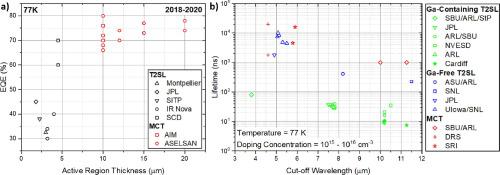Infrared Physics & Technology ( IF 3.3 ) Pub Date : 2021-04-24 , DOI: 10.1016/j.infrared.2021.103756 Dominic Kwan , Manoj Kesaria , Ezekiel Anyebe Anyebe , Diana Huffaker

|
Type-II superlattices (T2SLs) hold enormous potential for next-generation 8 – 14 μm long-wavelength infrared (LWIR) detectors for use at high operating temperature (HOT). The inherit flexibility of the material system has enabled the incorporation of unipolar barriers to eliminate generation-recombination currents and enhance device performance. In addition to suppressed Auger recombination and tunneling currents, this has led to sustained research interest in this material system over the past several decades. For these reasons, they are theoretically predicted to outperform the current state-of-the-art Mercury Cadmium Telluride (MCT) detectors. This review provides an overview of LWIR T2SL detectors and highlights some recent developments towards HOT applications. Recent studies on the minority carrier lifetime and diffusion length of T2SLs are examined to appraise the extent to which they limit the performance of HOT LWIR T2SL detectors. Strategies for mitigating these limitations are also explicated.
中文翻译:

8-14 µm II型超晶格红外探测器的最新趋势
II型超晶格(T2SL)对于在高温(HOT)下使用的下一代8 – 14μm长波长红外(LWIR)检测器具有巨大的潜力。材料系统的继承灵活性使单极性势垒得以并入,从而消除了重组电流并增强了器件性能。除了抑制俄歇复合和隧穿电流,在过去的几十年中,这引起了对该材料系统的持续研究兴趣。由于这些原因,从理论上讲,它们的性能将超过当前最新的碲化汞镉(MCT)检测器。这篇综述概述了LWIR T2SL检测器,并重点介绍了HOT应用的一些最新进展。审查了有关T2SL的少数载流子寿命和扩散长度的最新研究,以评估它们限制HOT LWIR T2SL检测器性能的程度。还阐述了缓解这些限制的策略。



























 京公网安备 11010802027423号
京公网安备 11010802027423号